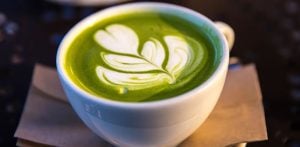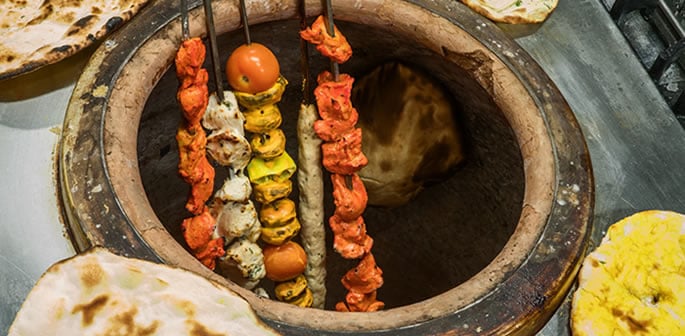the tandoor was as common as a water well
There is something hypnotic about a glowing tandoor.
The barrel-shaped clay oven radiates heat from smouldering coal or wood, its walls ready to blister naans and roast marinated meats to smoky perfection.
The sizzle of kebabs meeting fire, the charred aroma of bread clinging to its walls, and the rising waves of heat make it feel almost ritualistic.
It is primal yet precise, ancient yet surprisingly modern.
For centuries, this earthen oven has been more than a cooking tool. It is a symbol of community, migration and reinvention, a link between heritage and innovation.
Today, you will find tandoori chicken paired with avocado salsa in California, naan pizzas in London, and tandoor-smoked carrots plated like modern art in Copenhagen.
Yet its origins are far humbler. Before it became a global culinary icon, the tandoor was a fixture of the North-West Frontier Province, embedded in courtyards and roadside dhabas, far from the gaze of Michelin stars or Instagram feeds.
Its story is one of fire, flavour and resilience, a journey from rural villages to the world stage.
Born in the Frontier
![]()
The tandoor’s story begins in undivided Punjab and the North-West Frontier, regions that now lie mostly in modern-day Pakistan.
In those villages, the tandoor was as common as a water well or a cattle shed.
It was a communal, functional oven, built into courtyards, where women baked bread and roasted vegetables, and at truck-stop dhabas where men gathered to warm themselves with food and fire alike.
This earthy routine was abruptly disrupted in 1947.
Partition forced millions to leave their ancestral homes, sparking one of the largest human migrations in history.
Among those fleeing were Punjabi Hindus and Sikhs, who carried more than just steel trunks and heirlooms across the new border into India.
They brought memories, recipes and an unassuming clay oven that would shape the food culture of their new home.
The tandoor became a vessel of both survival and nostalgia.
In refugee camps and resettled neighbourhoods, the familiar crackle of fire and scent of roasting bread offered comfort in the chaos.
From this upheaval emerged a refugee cuisine that would transform Delhi’s culinary landscape forever.
The Moti Mahal
![]()
The tandoor’s leap from humble village kitchens to culinary stardom can be traced to one name: Moti Mahal.
Opened in Delhi’s Daryaganj by Kundan Lal Gujral, a refugee from Peshawar, the modest restaurant became the epicentre of tandoori innovation.
Gujral had experimented with tandoori chicken before Partition, but it was at Moti Mahal that his creations captured national attention.
The turning point came from an accident of ingenuity: to avoid wasting leftover tandoori chicken, Gujral dunked it into a creamy tomato gravy.
This improvisation became the legendary butter chicken, an instant classic when paired with naan baked in the same fiery oven.
Soon, Moti Mahal was drawing the elite and the curious alike.
Prime Minister Jawaharlal Nehru was a frequent visitor. International dignitaries, including US President Richard Nixon, dined there, taking stories of smoky chicken and buttery gravies abroad.
From one small restaurant, the tandoor began its journey from Delhi to the rest of the world.
Global Expansion
![]()
In the following decades, the tandoor only grew in influence.
Highway dhabas in Punjab and Haryana refined their techniques, perfecting smoky seekh kebabs and crisp tandoori rotis.
These roadside kitchens that once served truckers and farmers became pilgrimage spots for flavour-seekers.
Indian cities quickly caught on. Restaurants in Mumbai, Kolkata and Bangalore began incorporating tandoori dishes into their menus, giving urban diners a taste of smoky North Indian cuisine.
Even in regions far from the tandoor’s birthplace, the flavour became shorthand for “authentic Indian“.
The real global leap began in the 1960s and 1970s, as Indian chefs migrated to the UK, the US and beyond.
They carried the tandoor with them, building the first generation of Indian restaurants abroad.
For many international diners, tandoori chicken was their introduction to Indian food: smoky, spicy and endlessly comforting.
Butter chicken, though born in Delhi post-Partition, became a “classic” that felt as timeless as the oven itself.
By the late 20th century, the tandoor had transformed from a village oven into a culinary ambassador.
Its charred flavours and rustic charm became India’s calling card at diplomatic dinners and international food festivals.
Fine Dining
![]()
In the 21st century, the tandoor experienced yet another reinvention, this time in the realm of fine dining.
Chefs began exploring how the primal heat of the clay oven could meet the precision of haute cuisine.
At London’s Kutir, Chef Rohit Ghai uses the tandoor to create dishes plated with tweezers and edible flowers, yet the essence of smoky char remains.
In Bangkok, Gaggan Anand elevates tandoori lamb chops into a dish that is both modernist and deeply rooted in traditional fire-cooking.
In New York, Chef Chintan Pandya at Dhamaka brings the tandoor’s boldness to fiery game meats, refusing to dilute spice or authenticity for Western palates.
Meanwhile, experimental chefs in Copenhagen are building Scandinavian tandoors to replicate flavours Indian cooks have known for centuries.
Back home in India, the tandoor is thriving in new forms, from gourmet Goan kitchens to Jaipur rooftop cafes and vegetarian Gujarati restaurants.
Modern menus now feature millet naans, locally sourced meats, and artisanal dips, proving that the tandoor’s relevance is not just preserved but renewed.
Tandoori Beyond Meat
![]()
Although the tandoor is synonymous with kebabs and chicken, its vegetarian evolution has been remarkable. Chefs are embracing the oven’s versatility to create bold, vegetable-forward dishes.
You will now find tandoor-roasted broccoli dusted with amchur, cream cheese-stuffed mushrooms, and even smoky jackfruit as highlights on contemporary menus.
Pineapples, burrata, and pasta are also meeting the clay oven, resulting in dishes that surprise as much as they satisfy.
This innovation reflects a larger culinary shift.
The tandoor is no longer just an oven for meat; it is a technique, a flavour profile, and a global trend.
Across India and abroad, “tandoor” signals smoky daring, a badge of culinary boldness that appeals to adventurous young diners.
The brilliance of the tandoor lies in its simplicity: an earthen oven, coal or wood, and the instinct of the cook.
Yet its journey has been anything but simple.
It has travelled from the villages of the Frontier to Delhi’s refugee kitchens, from highway dhabas to Michelin-starred tables in London, Bangkok and New York.
Even today, community tandoors survive in rural Punjab and Pakistan, where neighbours bake rotis together, sharing gossip as they wait for the fire to work its magic.
Every naan, kebab or smoky vegetable that emerges from a tandoor carries this layered history of migration, memory and adaptation.
So, the next time you scoop up dal makhani with a pillowy naan or slice into tandoori octopus in Paris, remember: you are tasting centuries of resilience and reinvention.
The tandoor has a flame that refuses to die out, a story of fire and flavour that continues to burn bright.





























































